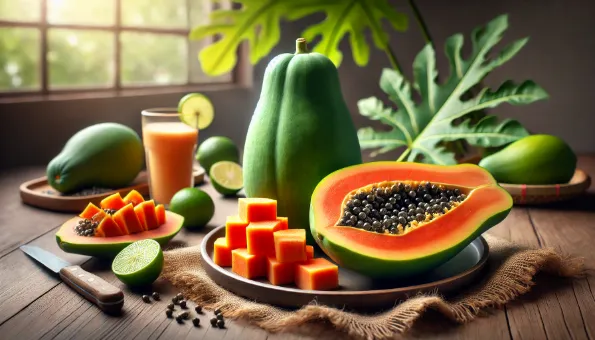Papaya: Tropical Orange Fruit Rich in Vitamin C, Provitamin A Carotenoids, Fiber & Digestive Enzymes
Juicy, lightly sweet papaya supplies vitamin C, folate, fiber and papain—supporting digestion and colorful antioxidant intake with only ~60 kcal per cup.

What Is Papaya?
Papaya (*Carica papaya*) is a **tropical berry-like fruit** with soft orange to salmon flesh, edible black peppery seeds and a buttery texture. Ripe papaya tastes mildly sweet with musky floral notes; green (unripe) papaya is firm, pale and used as a vegetable in salads & stews.
Nutrition (1 cup ripe papaya cubes • 140 g)
| | Amount | %DV |
|---|---|---|
| Calories | 55–60 kcal | — |
| **Carbohydrate** | 15 g | 5 % |
| – Fiber | 2.5 g | 9 % |
| **Protein** | <1 g | — |
| **Vitamin C** | 88 mg | 98 % |
| **Vitamin A (RAE)** | 68 µg (≈ 1350 IU) | 8 % |
| Folate (B9) | 54 µg | 14 % |
| Potassium | 264 mg | 6 % |
| Vitamin K | 3.8 µg | 3 % |
Provides **carotenoids** (β-carotene, lycopene), **flavonoids** and the proteolytic enzyme **papain** (mostly in latex of skin & unripe fruit).
Potential Benefits
- **High vitamin C + carotenoids** support immune function and antioxidant defense.
- **Papain & related cysteine proteases** (more in green fruit) can help tenderize proteins and may aid digestion of large protein meals (culinary tenderizer effect).
- **Moderate fiber + high water** add volume with relatively low calories (satiety friendly).
- **Folate & provitamin A** contribute to cell growth and eye/skin health.
- Color diversity (orange/red lycopene) broadens dietary phytonutrient spectrum.
Drawbacks & Precautions
- **Latex allergy cross-reactivity:** Individuals allergic to natural rubber latex may react to papaya (especially unripe, higher latex).
- Very unripe green papaya contains **higher latex** which can irritate if consumed in large raw amounts.
- Overripe fruit can ferment → off flavors / soft mushy texture; discard if sour or effervescent.
- Enzyme activity diminishes with **heat**; cooked papaya delivers nutrients but less protease function.
Culinary Uses
- **Ripe:** Eat fresh with lime, blend into smoothies, salsa (papaya + chili + cilantro + lime), fruit salads, or purée for sorbets.
- **Green (unripe):** Julienne for Thai-style salads (with lime, fish sauce or vegan alternative, peanuts) or add to curries & stews where it softens and absorbs flavors.
- **Seeds:** Peppery; dry & grind as a mild pepper substitute (use sparingly—slightly bitter).
- **Tenderizing:** Papain-rich green papaya purée can be used as a **meat or legume tenderizer** (marinate ≤ 2 hours to avoid mush).
Selecting & Ripening
- Choose fruit with **mostly yellow/orange skin**, yielding slightly to gentle pressure.
- Green with slight yellow patches will ripen at room temp in 2–3 days (speed up by placing in paper bag with banana).
- Avoid deep black molds or large sunken spots; superficial latex patches are normal.
Storage
Ripen at **room temperature** until colored & aromatic, then refrigerate whole or cut. Cut papaya (covered) keeps **2–3 days** chilled. Do not store unripe fruit in refrigerator—it halts ripening and can cause chill injury.
Sustainability Notes
Papaya grows rapidly and can yield fruit within a year, providing **high output per land area**. Buying **locally grown or Fair Trade** where available and using all edible parts (including seeds) reduces waste. Peel + seeds are compostable.
Key Takeaways
✔︎ Vitamin C & carotenoids rich tropical fruit
✔︎ Contains digestive enzymes (papain) & moderate fiber
✖︎ Latex cross-reactivity possible; enzyme activity reduced by cooking.
- 1. Papaya
Incidental ingredient mentioned in text

